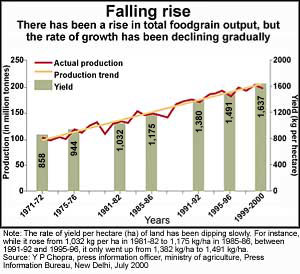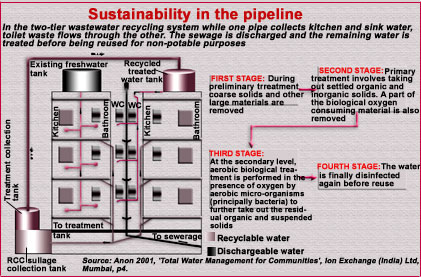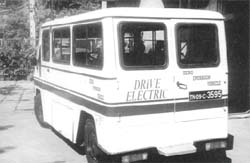
Protest damned
The first tremors of ego clashes have rattled the anti Tehri dam movement

The first tremors of ego clashes have rattled the anti Tehri dam movement

Voluntary groups in Madras are taking up the onus of increasing AIDS awareness among various groups including students, blue collar workers and truck drivers
North eastern NGOs are caught in the crossfire between militants and intelligence agencies

Officials are now promoting a new paradigm for flood control. They are pushing for a huge dam in Nepal. Does it provide scope for further corruption?
JOINT implementation was the main point of discussion at the recent meeting of the intergovernmental committee on climate change in Geneva. The idea of joint implementation has been promoted
How Vedanta's refinery came up How did Vedanta complete its refinery on schedule amid this fuss? With a little bit of help from the Orissa government and moef, it seems. Despite
We have to remember that we have no choice but to demand an effective climate convention

Behold: eco development is here, again
What makes a species invasive?

Dreams of vibrant, democratic units of self-governance in urban areas may take just a little longer to be realised

There was fear in the 1960s. Would India continue to wait for food imports to feed itself? The scientific community came up with an answer that gave hope for all times to come: the Green Revolution. Yields began to rise. The country had surplus foodgrain.

How does public interest advertising work on Doordarshan? Even more to the point, does it work at all?

Put into effect in earnest, the law on wastewater recycling can provide lasting relief to a parched Delhi. <font class='UCASE'>samreen farooqui </font> delves into the issue <br>

For a fortnight, 1,456 delegates from 167 countries sat in conference halls, attended plenary sessions and roundtables, and sized each other up over a cup of coffee. In the end, CoP 8 didn't witness any scintillating intellectual and moral leadership from

A weather event which Peruvians once regarded as a boon is now recognised as causing terrible global disasters
<p>One of the major events organized by the Ministry of Urban Development is the Urban Mobility Conference held in New Delhi in the first week of December each year. The theme of the latest conference held on 3rd, 4th and 5th of December 2010 at the Grand Hotel, New Delhi was “Sustainable Urban Transport: Accessibility and Inclusive Cities”.
<table align="center" cellpadding="0" cellspacing="0" width="740"> <tbody> <tr> <td class="p"> <div align="center"> <div class="txt padB10 pad10T"> <p class="txt MgnT2"> </p>
With ample sunlight almost around the year, one possibility is to use of solar energy to generate electricity in apartments and township projects in Chennai, writes Durganand Balsavar Steady strides: Solar Examples of how Solar Power is harnessed and used . House in Canada has solar panels on the roof. Impacted by the global context, Chennai is experiencing dramatic change with ever-increasing pressure from growing populations. Rapid urbanisation has resulted in considerable increase in the use of energy and fuel, consequently polluting atmosphere through the release of toxic emissions. This situation calls for a rapid and fundamental reorientation in our thinking, particularly on the part of planners and institutions involved in the process of urban development. The form of our future built environment must be based on a responsible approach to an ecological balance and the use of the inexhaustible energy potential of the sun. Buildings, in urban areas, are major consumers of energy. It has been estimated that in the US, residential and commercial buildings together use two-thirds of all electricity consumed in the country. While the situation is not as acute in India, increasing demands on urbanisation may push in that direction. The percentage of urban population in India increased from 18.0 in 1961 to 27.8 in 2001. The energy consumption raised threefold, from 4.16 to 12.8 quadrillion Btu between 1980 and 2001, putting India next only to the US, Germany, Japan and China in total energy consumption. There is greater recognition that it is time to take meaningful initiatives in this direction, through creating awareness of what are called 'green' buildings. Solar energy paradigm Solar lamp. With ample sunlight almost around the year, one possibility is through use of solar energy and other renewable energy sources to generate electricity to meet the needs of residential buildings in Chennai. At an urban scale similar initiatives could be undertaken to provide solar powered streetlights and other public facilities. Delhi government has decided to pass an order for compulsory use of solar power for advertising hoardings and water heating in government and some categories of buildings. The order also says that lights of advertisement hoardings shall be powered by solar photovoltaic systems at the cost of the franchisee and conventional streetlights shall be replaced by solar photovoltaic powered ones. Tsunami experiences In Tamil Nadu, renewable energy is now making a gradual impact especially in rural areas. Simultaneously though, its utilisation in urban and semi-urban areas has not yet been growing at the desired pace. Wind energy and solar energy seem to be the most preferred at this stage. Pertinent to mention here is that the Ministry of New and Renewable Energy (MNRE) has initiated a programme at the national level assisted by academic & research organisations, solar equipment manufacturers, and funding institutions like the Indian Renewable Energy Development Agency (IREDA). At the State level Non-Governmental Organisations have also, in the absence of infrastructure in rural regions, have invariably relied on solar energy sources. For instance, over the last three years, in coastal Tamil Nadu, affected by the tsunami, several rehabilitation and rebuilding programs were dependant on solar energy for their sustainability. Several temporary shelter enclaves were equipped with cost-effective solar lights and solar fans, in the absence of links to the TNEB network in remote inaccessible areas. The solar street lights are manufactured by companies such as Tata BP Solar. Though the initial cost of investment is relatively higher than the conventional systems, in the long term, in remote rural areas, solar energy has gradually come to be accepted as a more reliable alternative. Solar energy in Chennai Solar street light. If experiments to introduce solar energy are workable in housing settlements in Nagapatinam and Ladakh, a more systematic and concerted effort to explore the possibilities and constraints of introducing such systems in Chennai and other fast growing urban areas is required through the cooperative efforts of the various stakeholders. At a purely theoretical level, the unutilised surface area of the terraces of buildings in the city itself should provide enough incentive to gradually shift to renewable sources like solar energy. In addition balconies also become potential areas to harvest solar power. Even slopped roofs with tiles can accommodate solar panels. The present technology allows for less conspicuous solar array on the roof and they can harvest more energy with less space. In residential developments, the immense potential for use of solar energy equipment exists, through solar lights in common areas and open spaces, gateways, solar fans, solar water heaters and even the possibility of solar cookers in the kitchen. While it could dramatically reduce the consumption of electricity, savings in electricity bills could offset the initial investments. The fact remains that in harnessing it effectively, several initiatives are required.. A nominal solar power backup system UPS that can run 2 lights a fan and a TV can cost about Rs. 28,000/-. These systems have a 20-year durability and a battery life of 3 years. Apprehensions that a cloudy day could mean that there is no solar power need to be allayed.Several solar systems do have back-up energy systems to tide through a few days of cloudy weather. More user-friendly equipment could also facilitate its use on a larger scale. Concerns voiced by environmentalists on the excessive production of photovoltaic solar cells containing silica also need careful examination before deploying the technology. An integrated awareness of the benefits and constraints of solar energy and its sustainability over the long term in conserving and protecting our environment is essential. In order to attain these goals, it will be necessary to modify existing courses of instruction and training, as well as energy supply systems, funding and distribution models, standards, statutory regulations and laws in accordance with the new objectives. The author is an architect practising in Chennai and a visiting faculty at School of Architecture and Planning, Anna University.

Fuel cells are more important to a developing country like India than developed countries. But the corporate sector is slow.

Militancy has destroyed much more than peace in Kashmir. Kalashnikov trotting extremists are ravaging the last green frontiers of the 'heaven on earth'. Even the Army is accused of active complicity. Eco vandalism has certainly emerged as a lucrative deal